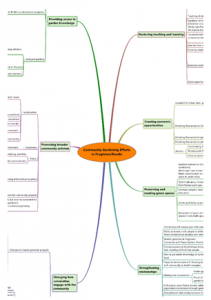I am Scott Chazdon, Evaluation and Research Specialist with the Extension Center for Community Vitality, University of Minnesota. I have gained skills in a process known as Ripple Effect Mapping (REM) to document impacts of Extension community development programs. REM sessions often spur important thinking, connections and work.
REM is a participatory group method that engages program and community stakeholders to retrospectively and visually map the chain of effects resulting from a program or complex collaboration. The REM process combines elements of Appreciative Inquiry, mind mapping, group interviewing, and qualitative data analysis. It is a powerful tool for documenting both the intended and unintended results of a program. It is also a way to engage and re-energize program participants and stakeholders around shared goals.
Rad Resource: A more in-depth introduction to REM is at University of Minnesota Extension feature article on REM – “Ripple effect mapping makes waves in the world of evaluation”
Lesson Learned: What started as a great method for evaluating community leadership programs morphed into a tool for a broad range of programs.
In Minnesota, an effort to document the impact of urban Master Gardeners working in the neighborhoods became a more inclusive and community-driven project that showcased the many different outcomes of the program that may have been overlooked. Here is a thumbnail graphic of the core section of the Ripple Effect Map from that project.
Rad Resource: You can find full-sized REM graphics at this site University of Minnesota Extension REM Blog
Lesson Learned: Recruiting the right number and mix of people is crucial in Ripple Effect Mapping. In terms of numbers, these are larger than focus groups, but if you go beyond 20 people you may not be able to include all voices in the process. I prefer groups of 12 to 20 people.
You can invite both direct participants and non-participant stakeholders. This non-participant group can include funders, local elected officials, other influential figures, or representatives of the media.
Lesson Learned: This mix of people creates an insider-outsider dynamic that sometimes leads to game-changing insights about efforts that have already happened, as well as efforts that could happen! That’s why Ripple Effect Mapping makes sense as a developmental evaluation tool.
Rad Resources: To find out more about REM and approaches that can be taken, as well as if might be a tool you can use, take a look at these two articles: 1) Journal of Extension — Using Ripple Effect Mapping to Evaluate Program Impact: Choosing or Combining the Methods That Work Best for You and 2) Journal of Extension — Ripple Effect Mapping: A “Radiant” Way to Capture Program Impacts
The American Evaluation Association is celebrating Extension Education Evaluation (EEE) TIG Week with our colleagues in the EEE AEA Topical Interest Group. The contributions all this week to aea365 come from our EEE TIG members. Do you have questions, concerns, kudos, or content to extend this aea365 contribution? Please add them in the comments section for this post on the aea365 webpage so that we may enrich our community of practice. Would you like to submit an aea365 Tip? Please send a note of interest to aea365@eval.org. aea365 is sponsored by the American Evaluation Association and provides a Tip-a-Day by and for evaluators.


Scott, I am very interested in the Ripple Effect Mapping – it seems well suited to working to a project I am working on. I will contact you soon.
Kate Gill Kressley